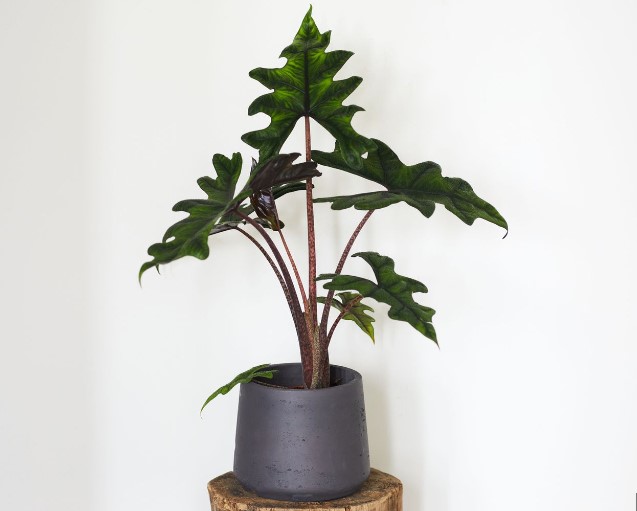
Alocasia plants are prized for their stunning foliage and tropical charm, but meeting their lighting needs is key to keeping them healthy and thriving. Whether you’re a seasoned plant owner or a new gardener, understanding the type of light Alocasias require can make all the difference. This guide explores the lighting needs of Alocasia plants, tips for providing optimal conditions, and how to troubleshoot common lighting issues.
Understanding Alocasia’s Native Habitat
Alocasia plants originate from tropical rainforests in Asia, where they grow under the canopy of taller trees. This environment provides them with filtered, indirect sunlight, mimicking dappled light through the forest. Replicating these conditions indoors or in your garden is crucial for their health and growth.
What Kind of Light Does Alocasia Need?
1. Bright, Indirect Light
- Optimal Condition: Alocasia plants thrive in bright, indirect sunlight. This mimics their natural rainforest habitat, where light is filtered through tree canopies.
- What It Means: Place your plant in a well-lit room but away from direct sunlight that could scorch its leaves.
2. Partial Shade
- Alocasias can tolerate partial shade, especially outdoors, but they perform best when they receive consistent, bright light for at least 6-8 hours a day.
3. Avoid Direct Sunlight
- Direct sunlight can scorch the delicate leaves, causing brown spots and edges.
- If outdoors, provide a shaded location or use a sheer curtain indoors to diffuse the light.
4. Low Light? Not Ideal
- Alocasia plants do not do well in low-light conditions. Insufficient light can lead to slow growth, leggy stems, or pale, droopy leaves.
Best Locations for Alocasia Plants
Indoors
- East-Facing Windows: Morning sunlight is gentle and ideal for Alocasias.
- South- or West-Facing Windows: Place the plant a few feet away or use a sheer curtain to filter the light.
- Bright Rooms: Any area with abundant natural light, such as living rooms or sunrooms, is a great spot.
Outdoors
- Under Shade Trees: Offers dappled light similar to their native environment.
- Covered Patios or Balconies: These areas provide protection from direct midday sun while still offering bright light.
Using Artificial Light for Alocasias
If your home doesn’t get enough natural light, grow lights can be an excellent alternative.
Types of Grow Lights:
- LED Grow Lights: Energy-efficient and customizable to provide the spectrum of light Alocasias need.
- Full-Spectrum Lights: Mimic natural sunlight and are ideal for long-term use.
- Fluorescent Lights: A good budget-friendly option, but less effective for larger plants.
Placement:
- Position the grow light 12-18 inches above the plant to avoid overheating the leaves.
- Provide 12-14 hours of artificial light daily, especially during shorter winter days.
Signs Your Alocasia is Getting the Right Light
Healthy Growth Indicators:
- Vibrant, Green Leaves: Consistent light keeps the foliage lush and glossy.
- Frequent New Leaves: A sign of a happy, well-lit plant.
- Upright Growth: Leaves remain firm and grow toward the light source.
Signs of Improper Lighting
1. Too Much Light
- Symptoms:
- Brown, crispy edges or spots on the leaves.
- Leaves may curl inward as a protective measure.
- Solution: Move the plant to a location with filtered light or add a curtain to diffuse direct sunlight.
2. Insufficient Light
- Symptoms:
- Yellowing leaves or pale foliage.
- Leggy growth, with stems stretching toward the light source.
- Slow or no new leaf development.
- Solution: Relocate the plant to a brighter spot or add a grow light.
Seasonal Adjustments for Alocasia Lighting
Summer
- Protect from harsh midday sun by relocating to partial shade or using a curtain indoors.
- Monitor soil moisture closely, as increased light can dry out the soil faster.
Winter
- Natural light decreases during winter, so place your Alocasia in the brightest spot available.
- Consider supplementing with grow lights for consistent light exposure.
FAQs About Alocasia Lighting
Q: Can Alocasias grow in low light?
- Alocasias can survive in low light but will not thrive. Growth slows, and leaves may become pale or droopy.
Q: How do I acclimate my Alocasia to brighter light?
- Gradually introduce the plant to brighter conditions over a week to prevent leaf scorch.
Q: Can I keep Alocasia under fluorescent office lights?
- Yes, but ensure the plant receives supplemental lighting for at least 12 hours a day to make up for the low intensity of fluorescent lights.
Q: How do I protect outdoor Alocasias from too much sun?
- Use shade cloths, plant them under trees, or move them to a location that gets morning sun and afternoon shade.
Tips for Success
- Rotate Regularly: Turn your Alocasia every few weeks to ensure even growth and prevent leaning toward the light source.
- Observe and Adjust: Monitor your plant for signs of too much or too little light and make adjustments as needed.
- Clean Leaves: Dust the leaves periodically to maximize light absorption and photosynthesis.
- Be Patient: New gardeners may need to experiment to find the perfect lighting conditions, but the effort is worth it!
Conclusion
Providing the right kind of light is essential for keeping your Alocasia healthy and thriving. These tropical plants flourish in bright, indirect sunlight, mimicking their natural rainforest habitat. Whether you’re working with natural light, grow lights, or a combination of both, understanding and adjusting to your plant’s needs will ensure it rewards you with stunning, vibrant foliage.
Set your Alocasia up for success by mastering its lighting requirements, and watch it become the centerpiece of your indoor or outdoor space!






